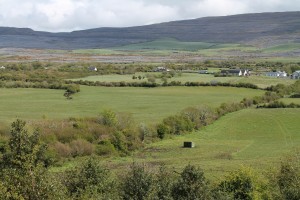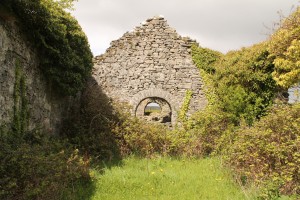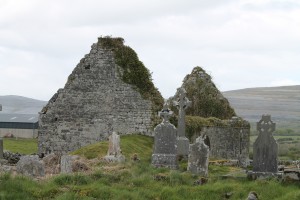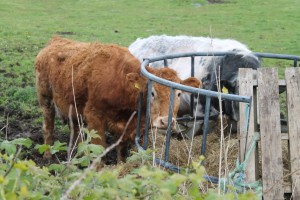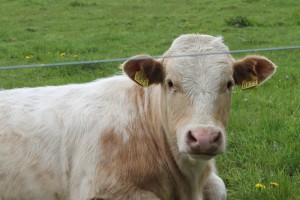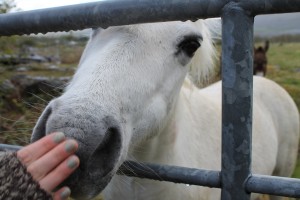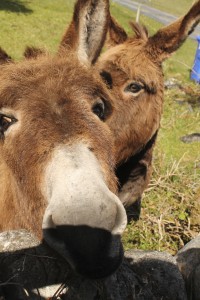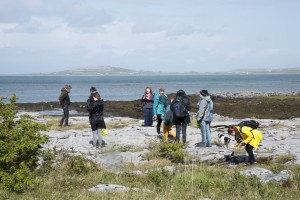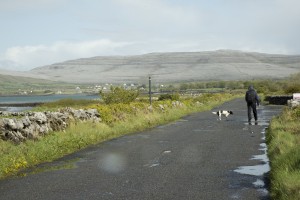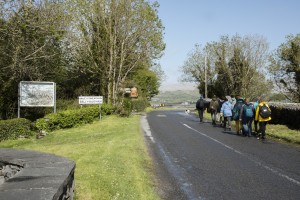We’re off to a wonderful start with a wonderful group. Here’s a quick accounting of our adventures so far:
Saturday morning, we managed to assemble in Shannon airport. The flights were pretty much on time, which gave the early arrivers (Judith, Bruce, Emily, Meg, Quinn) a chance to have a quick snooze on the benches before the last plane came in. Then we picked up Kaitlyn and Erin at the West County Hotel and enjoyed a spectacular drive through the Burren to Ballyvaughan.
Bruce’s famed cure for jet-lag is daylight and exercise, so after just enough time for a rest we took off for a hike. We checked out the Burren College Campus, then trekked the long way down to the waterfront. Along the way, a beautiful little sheepdog mix adopted our group, training her puppy-eyes especially on Bruce (today a whole herd of cows followed him down the road — who knew he was such an animal whisperer?). Our group named the dog “Hike,” and she cheered us through a pelting rainstorm as we walked. We ended up at Monk’s, where the staff thoughtfully brought in space heaters and closed off the back room to warm us up (or were they perhaps keeping us out of sight?) for our first shared dinner of the trip. Afterwards, tired as we all were, we met at my house and performed Gaelic language skits. I was so impressed by everyone’s efforts!
Sunday was a marathon tour of the Burren. Mike and Stephen, our driver and guide respectively, took us to Caher Mor, Poulnabrone Dolmen, Leminagh Castle, and Kilfenora Cathedral before much-needed stops in Ennistimon for groceries and in Lahinch for l-ah-unch. (Michelle S and Chloe bravely tasted periwinkles from a sea-front vendor.)The afternoon saw us whizzing through Liscanor to see St. Brigid’s Well and O’Brien’s monument, buffeted by winds at the Cliffs of Moher, photographing gentians at Fanore, then taking the coast road back past the Pinnacle Well to Ballyvaughan. (Hey, gals — please post pictures and your own highlights from that day — If I had a nickel for each time one of you said, “Let’s come back to this spot….” I could singlehandedly prop up Ireland’s sagging economy).
Today, Monday, was actually our first day of “classes.” It started with tea/coffee and cookies, and a welcome from Mary Hawkes-Green. Robert Ellis took us on a tour of the college and everyone picked out their studio spaces. After lunch in the BCA Cafe (thank goodness Anne and Martina are still cooking!), we convened in the tower to talk about mythology in front of a peat fire. (Thank you, Kaitlyn, Meg, and Erin!)
The weather had turned lovely, so we hiked out to the ring fort near Ailwee Caves…. where the weather turned un-lovely again, just as we arrived to do some writing. If you don’t like change and surprises, don’t visit Ireland. Despite the wind, some of us remained to write in the ring, while the rest hiked back to write where the pages of their notebooks weren’t whipping out of their hands with every word. We finished the day (and the writing exercise) back at the studios.
That’s all just a quick overview of our itinerary for the past 48 hours. We’re windblown, footsore, and a little bit damp, but I am so impressed by the spirit and good nature of this group. And our adventures are just beginning!

